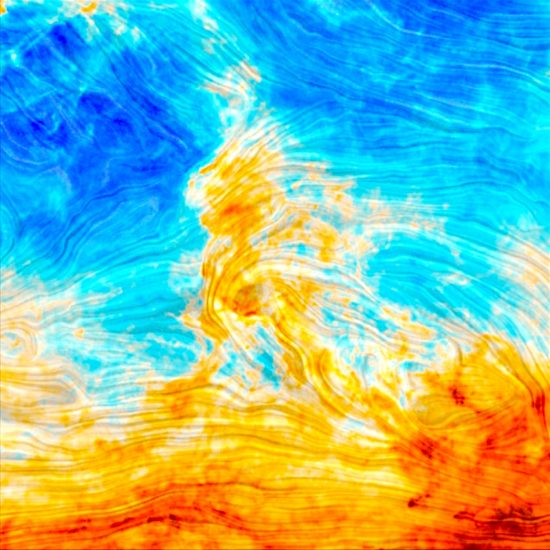
The Polaris Flare. Credit: ESA and the Planck Collaboration
Aug 26, 2016
The Universe reveals itself through electrical phenomena.
The above image of the polaris Flare is derived from observations by the Planck satellite, now defunct, that was launched by the European Space Agency (ESA) in May 2005, along with the Herschel Space Observatory.
According to a recent announcement from ESA, small dust grains, said to be rotating at several million times per second, are constrained by magnetic fields that create channels through which light can be emitted. That effect causes the light to be polarized. Conventional astrophysical models see the Polaris Flare filaments developing from “shockwaves pushing their way through a dense interstellar cloud”, or “sonic booms…triggered by nearby exploding stars…”
Regardless of whether it is shock waves or sonic booms, the effects in conventional theories are presumed to result from kinetic and mechanically induced inputs. In fact, lowering thermal activity is how stellar formation theories say star birth begins.
In an Electric Universe, mechanical phenomena give way to the effects of plasma. The stars are not hot, dense balls of hydrogen, they are balls of plasma with all the fusion taking place on their surfaces; they have no superdense fusion cores. The Electric Universe definition of plasma is not the conventional one that refers to “ionized gas”. Plasma is an emergent phenomenon that includes ordered complex electrical forces: filamentation, long-range attraction and short-range repulsion, filament braiding, formation and decay of plasmoids, and scalability of all properties.
Previous observations by the Fermi Gamma Ray Space Telescope indicate that there are twin lobes of gamma rays in an hourglass shape extending out of the Milky Way’s central bulge. Each measures approximately 65,000 light-years in diameter. They are an unmistakable characteristic of Birkeland currents squeezing plasma and charged dust into z-pinch zones. Intense magnetic fields associated with Birkeland current filaments cause electrons to accelerate with velocities close to the speed of light. Those excited electrons emit synchrotron radiation, the principle source for gamma rays in space, as well as other high frequency wavelengths.
There are “radio lobes” extending far from active galaxies that signify the presence of electric charge flow, while the spiral arms of some galaxies exhibit twisted strands. Those filaments are Birkeland currents, but they represent only the visible portion of their electric circuits: a halo of stars, filamentary structures, lobes of radiation, a microwave “haze,” and polarized magnetic fields point to their electrical nature.
Rotating dust grains are not the most likely reason that Planck found polarized light. ESA refers to “magnetic fields” in its announcement, but for magnetic fields to exist, electric fields must also be present. It is an electromagnetic force, not merely a magnetic force that guides light waves. Provided that the Planck detectors actually saw what was reported, polarization in the Milky Way could be caused by the Zeeman effect.
The Zeeman effect is named for Pieter Zeeman, a Dutch physicist. It splits spectral lines in the presence of a magnetic field, with triple or double splitting sometimes seen. Based on the direction of detection, polarization is different: circular polarization occurs in the longitudinal rotation for the two high and low bands of a triplet, while in the middle, or transverse band, light is polarized parallel to the magnetic field, and the other two bands are perpendicular.
Since the Milky Way is threaded with filaments of electromagnetic Birkeland currents, it could be that Planck is seeing polarization from the fields associated with them.
Stephen Smith












